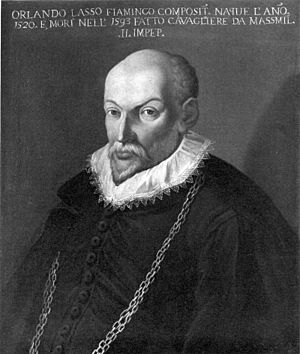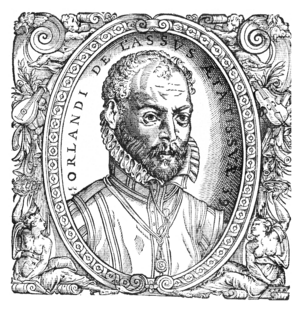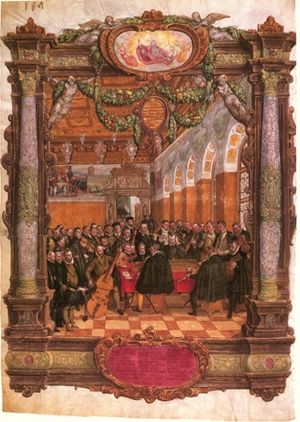Orlande de Lassus facts for kids
Orlande de Lassus (born around 1532 – died 14 June 1594) was a famous composer from the late Renaissance period. He was a leading figure in the Franco-Flemish school of music, known for his complex musical style called polyphony. Lassus is considered one of the most important composers of his time, alongside Giovanni da Palestrina and Tomás Luis de Victoria. He wrote a huge amount of music in many different styles, which made him very popular across Europe.
What's in a Name?
Lassus's name was spelled in many ways. This often changed depending on where his music was performed or published. Besides Orlande de Lassus, you might see his name as Roland de Lassus, Orlando di Lasso, Orlandus Lassus, Orlande de Lattre, or Roland de Lattre.
Lassus's Life and Musical Journey
Orlande de Lassus was born in Mons, which is now part of Belgium. We don't know much about his early life. But there are stories that he was kidnapped three times! This was because his singing voice was so beautiful.
When he was about twelve, he left his home. He traveled with a nobleman named Ferrante Gonzaga. They went to Mantua, Sicily, and then Milan (from 1547 to 1549). In Milan, he met a composer named Spirito l'Hoste da Reggio. This meeting greatly influenced Lassus's early music style.
He then worked as a singer and composer in Naples in the early 1550s. His first musical works probably came from this time. After that, he moved to Rome. There, he worked for Cosimo I de' Medici. In 1553, at just 21 years old, he became the maestro di cappella (music director) of the Basilica of Saint John Lateran. This was a very important job! But he only stayed for one year.
We don't have clear records of where he was in 1554. But some say he traveled to France and England. In 1555, he returned to the Low Countries. His early works were published in Antwerp around this time.
In 1556, Lassus joined the court of Duke Albrecht V in Munich. The Duke wanted to create a music center as good as those in Italy. Lassus was one of several musicians from the Netherlands to work there, and he was the most famous. He seemed happy in Munich and decided to stay. In 1558, he married Regina Wäckinger. They had two sons who also became composers. His daughter married a painter. By 1563, Lassus became the main music director for the Duke. He stayed with the Duke and his son, Wilhelm V, for the rest of his life.
By the 1560s, Lassus was very well known. Other composers, like Andrea Gabrieli, came to Munich to study with him. His fame spread beyond just music. In 1570, Emperor Maximilian II made him a nobleman. This was very rare for a composer! Pope Gregory XIII also made him a knight. The king of France, Charles IX, invited him to visit in 1571 and 1573.
Some powerful rulers tried to get him to leave Munich with better offers. But Lassus liked the steady job and the great chances to perform at Albrecht's court. He wasn't as interested in more money. In 1580, he wrote to the Duke of Electorate of Saxony about an offer from Dresden. He said, "I do not want to leave my house, my garden, and the other good things in Munich."
In the late 1570s and 1580s, Lassus visited Italy several times. There, he saw the newest music styles. In Ferrara, a center for new ideas, he heard the latest madrigals. However, his own music style stayed more traditional. It became simpler and more refined as he got older.
In the 1590s, his health began to get worse. He saw a doctor for what was called "melancholia hypocondriaca" (a type of sadness). But he still composed and traveled sometimes. His last work is often seen as one of his best. It was a beautiful set of 21 spiritual madrigals called Lagrime di San Pietro ("Tears of St. Peter"). He dedicated this work to Pope Clement VIII. It was published after he died in 1595.
Lassus passed away in Munich on June 14, 1594. This was the same day his employer decided to let him go for money reasons. But Lassus never saw the letter. He was buried in Munich.
Lassus's Music and Its Impact
Lassus was one of the most productive and varied composers of the late Renaissance. He wrote over 2,000 pieces of music! These included songs in Latin, French, Italian, and German. He wrote in almost every type of vocal music known at the time.
His works include:
- 530 motets (sacred songs)
- 175 Italian madrigals and villanellas (secular songs)
- 150 French chansons (French songs)
- 90 German lieder (German songs)
It's interesting that no music for instruments alone by Lassus is known to exist. This is unusual for such a wide-ranging composer, especially since instrumental music was becoming very popular then. A German music publisher, Adam Berg, dedicated five books of his Patrocinium musicum (published 1573–1580) to Lassus's music.
Sacred Music: Music for Church
Lassus remained a Catholic during a time of religious disagreements. This didn't stop him from writing fun, worldly songs. It also didn't stop him from using parts of those songs in his church music. The Counter-Reformation, a Catholic movement, had a big effect on Lassus's later church music. This included music for church services, many Magnificats (songs of praise), and especially his spiritual madrigals, the Lagrime di San Pietro.
Masses: Church Services in Song
Lassus wrote almost 60 complete masses. Most of these are parody masses. This means he used melodies from other songs, sometimes even secular ones, as a starting point. His masses are technically impressive. He usually matched the style of the mass to the original song he used. But he always made sure the final mass sounded expressive and respectful.
Besides his traditional masses, he wrote many missae breves, or "brief masses." These were shorter, simpler masses for quick services. For example, on days when Duke Albrecht went hunting, he didn't want long, complex music. The most extreme example is the Jäger Mass (Missa venatorum), also known as the "Hunter's Mass."
Some of his masses show influence from the Venetian School. This is especially true in how he used polychoral techniques, where multiple choirs sing together. For example, his eight-voice Missa osculetur me uses this style. Three of his masses are for double choir. They might have even influenced the Venetian composers themselves. After all, Andrea Gabrieli visited Lassus in Munich in 1562.
Motets and Other Holy Songs
Lassus was one of the most varied and productive composers of motets in the Renaissance. Motets are sacred choral pieces. His motets range from very serious to quite funny. He even showed a sense of humor not often seen in church music. For example, one motet makes fun of bad singers. It includes stuttering and confusion!
Many of his motets were written for special events. As a court composer, he had to provide music for visits from important people, weddings, and other state events. But it was his religious motets that made him most famous.
Lassus's 1584 collection of the seven Penitential Psalms of David is very famous. It was ordered by King Charles IX of France. Some people believed the king ordered them to make up for the massacre of the Huguenots. Lassus's music in these psalms is very expressive. He uses different textures and pays close attention to the words. The second to last piece, his setting of the De profundis, is considered one of the best pieces of Renaissance polyphony.
He also wrote other church music. This includes hymns, canticles (over 100 Magnificats), responsories for Holy Week, and Lamentations.
Secular Music: Songs for Everyday Life
Lassus wrote in all the popular secular (non-religious) music forms of his time. In a book of his German songs, he listed his secular works: Italian madrigals, French chansons, and German and Dutch songs. He is probably the only Renaissance composer to write so much music in five languages: Latin, Italian, French, German, and Dutch. He wrote equally well in each language. Many of his songs became very popular and were heard all over Europe. In these songs, he used the style of the country they came from. But he always added his own unique touch, wit, and clear message.
Madrigals: Italian Love Songs
In his madrigals, many of which he wrote in Rome, his style is clear and simple. He wrote tunes that were easy to remember. He also often "signed" his work by using the word 'lasso' (which means 'tired' in Italian) or by using the musical notes la-sol (A-G). He chose many different kinds of poems for his madrigals. Some were serious, like those by Petrarch, and some were light and funny, like his canzonettas.
Lassus often preferred to group madrigals together. For example, his fourth book of madrigals for five voices starts with a complete sestina (a type of poem) by Petrarch. It then has two-part sonnets and ends with another sestina. So, the whole book can be heard as one long piece of music.
Chansons: French Melodies
Lassus also wrote about 150 French chansons. Most of these were from the 1550s. But he kept writing them even when he was in Germany. His last chansons were from the 1580s. They were extremely popular in Europe. Many were arranged for instruments like the lute and keyboard.
His chansons ranged from serious and dignified to playful and romantic. He also wrote drinking songs. Lassus followed the smooth, lyrical style of Claudin de Sermisy for his chansons.
One of Lassus's most famous drinking songs was even used by William Shakespeare in his play Henry IV, Part II. English words were put to the French song Un jour vis un foulon qui fouloit (as Monsieur Mingo). It is sung by the drunken Justice Silence in the play.
German Lieder: Songs in German
A third type of secular song Lassus wrote was the German lied. Most of these were for a different audience. They sound quite different from his chansons or madrigals. He also wrote them later in his life, starting in 1567. Many of these songs are about religious topics. But he also wrote light and funny songs. He wrote German drinking songs too. Unlike his French drinking songs, some of his German ones also talk about the bad side effects of drinking too much.
Dutch Songs: Lost Melodies
In the introduction to his German song collection, Lassus said he had composed Dutch songs. However, none of his Dutch songs have survived to this day.
See also
 In Spanish: Orlando di Lasso para niños
In Spanish: Orlando di Lasso para niños




